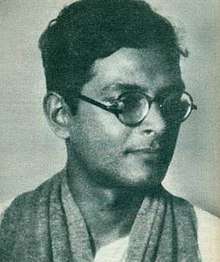Manik Bandopadhyay
Manik Bandopadhyay (![]()
Manik Bandopadhyay | |
|---|---|
 | |
| Born | Prabodh Kumar Bandhopaddhay 19 May 1908 Dumka, Bengal Presidency, British India |
| Died | 3 December 1956 (aged 48) Kolkata, West Bengal, India |
| Nationality | Indian |
| Occupation | Writer |
| Spouse(s) | Kamala Devi |
Early life
Bandopadhyay was born on 19 May 1908 in Dumka, a small town in Santal Parganas district in the state of Bihar in British India. His real name was Prabodh Kumar Bandhopaddhay. Owing to his dark complexion, he was known to his family members as Kala Manik (black diamond), or simply Manik.[5] His ancestral home was Bikrampur, in Dhaka district (present-day Bangladesh).[6] He was the fifth of the fourteen children of his parents, Harihar Bandopadhyay and Niroda Devi.[5] Harihar was a sub-registrar who was posted in different parts of Bengal.[5] This gave Manik to experience life and living of people in different parts of Bengal in his early life.[1]
Literary life
Once while he was with his friends in their college canteen, one of them asked him if he could publish a story in the magazine Bichitra. The would-be novelist replied that his first story would be good enough for the purpose. At that time, Bichitra was a leading periodical which carried stories only by eminent authors. Manik walked into the office of the periodical and dropped the story Atashi Mami (Aunt Atashi) in their letter box.[5] At the end of the story he signed off as Manik Bandhopadhay. After four months, publication of the story (in 1928) created sensation in the literary circles of Bengal and, from then on, the pen name stuck.
Social and political views
Manik carefully read Marx and Engels and became a Marxist. He became an active politician of Marxism by joining the Communist Party of India in 1944.[5]
Works
References
- Subodh Kapoor (2002). The Indian Encyclopaedia: Mahi-Mewat. Cosmo Publications. pp. 4605–. ISBN 978-81-7755-272-0. Retrieved 23 July 2012.
- Bardhan, Kalpana, ed. (1990). Of Women, Outcastes, Peasants, and Rebels: A Selection of Bengali Short Stories. Berkeley, CA: University of California Press. p. 19 – via Questia.
- Malashri Lal; Sukrita Paul Kumar (1 September 2007). Interpreting Homes in South Asian Literature. Pearson Education India. pp. 254–. ISBN 978-81-317-0637-4. Retrieved 23 July 2012.
- Nirmal Kanti Bhattacharjee (2008). "Manik Bandopadhyay: A Centenary Tribute" in the Indian Literature.
- Shamsad Mortuza (21 May 2018). "A Hunger Artist". The Daily Star. Retrieved 21 May 2018.
- "Bandyopadhyay, Manik - Banglapedia". en.banglapedia.org. Banglapedia.
Further reading
- Jugantor Chakrabarty (editor), Oprokashito Manik Bandopadhyay, 1976.
- Saroj Dutta, Ouponnasik Manik Bandopadhyay, 1993
- Nitai Basu, Manik Bandopadhyay'er Somaj Jijnasa, 1978.
External links
| Wikimedia Commons has media related to Manik Bandopadhyay. |